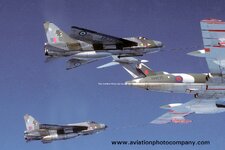Admiral Beez
Major
I was referring to your note above that no attempt was made to put bombs on their CF-101s, and that an attempt wasn't necessary since it was a known fighter bomber. Had the RCAF decided to use their CF-101s as bombers they would've just done it, no contemplation necessary.OK got ya but the CF-101 was never used in that role. The CF-101 never carried any air to ground weapons AFAIK - if I'm wrong, please enlighten me!

